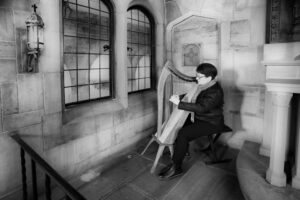Hi, I’m Cynthia Shelhart. You can call me Cindy. And it’s time for some Double Talk. Double-strung harp, that is.
Welcome to the first episode in my double-strung harp FAQ series. Harp lovers and harp players have been asking me questions about my instrument for a long time, and this is my chance to answer some of those questions for you.
We’ll start today with the most basic question of all: What’s a double-strung harp? How is it the same as other harps? How is it different? And what’s the big deal with two rows of strings? What can they do?
Same
Let’s get started with: how is it similar to other harps?
If you look at a double-strung harp from the side (but not too close, just yet), you’ll see that like single-row harps, it is a type of lever harp. Lever harps are tuned diatonically, or in a major scale. That’s like the white keys on a keyboard instrument or a do-re-mi scale.
And each string has a sharping lever that can be used to change the tuning of the string by one half step—for example, from a C natural to a C sharp, or an F natural to an F sharp—without manually shortening or lengthening the string with a tuning key. This saves a lot of time and effort for the harpist. And if you set the levers in different up and down combinations, that allows you to play in different musical keys. So, that’s something that’s the same with its single-row harp cousins.
Different
But what’s different?
Okay, come on over; get a little closer, look at the harp from a different angle. And you’ll see where the double-strung harp gets its name, or we might even call it a double harp, for short. You take a look at it, you can tell it gets the name from two rows of strings. Pretty straightforward. They are identically tuned: the C note across from the C note, from one row to the other, for example. Those are unison notes. They are identically tuned with each other. And two rows of strings, for one, one advantage allows both hands to have access to the entire range of notes on the harp, from low notes to high notes. And they can even overlap in the middle and not have a musical traffic jam.
It’s very rare for a harp to be able to not only be able to play unison notes with itself, but also to be able to play repeating notes, or special effects that involve repeating notes, without your hands trying to cancel each other out or muffle already vibrating strings. I’ll show an example here of what that looks like on a single-row harp and how that sounds. (harp example audio)
Spoiler alert: that doesn’t sound very good. But then try the same thing on a double-strung harp, and also play a little bit of overlapping music. So you can see and also hear the advantages that you get from two rows of unison-tuned strings. (harp example audios)
And also, if you look at the harp from the front angle of the harp, you can see that not only does it have two rows of strings, but it also has the possibility of having an entire set of levers on either row. Two full sets of levers, like this harp has. And I’ll talk more about double harp levers, and their settings and notation—how we, say, you set the levers this way or that way. Yeah, we’ll talk about those in future videos.
Wrapping Up
So that’s it for the introduction to the double-strung harp. It’s just enough like other lever harps to be familiar, but with two rows of strings, just different enough to get your attention.
If you liked what you heard today, please make sure you’re subscribed, so you can be notified. And if you want to be the first to get some more Double Talk, head on over to my website, CindyShelhart.com, and sign up for my mailing list.
In the next episode, I’ll dig a little deeper into those strings and levers and tunings that we use on double-strung harps. See you next time.

[…] first FAQ episode was a big-picture view of the double-strung harp. If you missed it, please make sure you’re […]